| Iíve been busy on a lot of projects and have been away from this magazine, youíll be seeing me more often and itís good to be back. I love surfing the Internet and the information thatís available there is incredible. There are several great sites for heating guys and we are very proud of our own Chat Room, DragonTalk. It not only houses a ton of information on oilheat, including a library of my old articles, but is also a lot of fun and another contribution to industry education.
Itís all about heating, with no-pop-ups, ads or other distractions. A while ago a thread started on the internet about checking low-water cutoffís that got me thinking about whether or not most techs know the correct procedure for doing this common task. In my steam and control seminars I know most techs are very upset to find out they donít, and so, here we go.
Story continues below ↓
advertisement | your ad here
ASME approval logos which are a four-leaf clover with a letter in the middle, are approvals given to boilers, valves and other devices legally called Ďappurtancesí that are found on steam or water boilers. ASME is the American Society of Mechanical Engineers, and having been a member since 1976 I tend to read an awful lot of their publications when they come to my door. That letter in the middle of the clover means something too. If itís an ĎHí it means youíre looking at a castiron boiler or section and if itís a steel boiler or tank the plate is welded on. If itís an ĎHVí that stands for hydronic valve and an ĎNí would mean youíre in the wrong place and looking at a reactor.
ASME has inspectors who not only approve this stuff after itís made, but actually work in many foundries and weld shops to check it while itís being made. The basic two manuals that boiler people live by is ASME Section IV which is a pretty big book and CSD-1 which is a standard for controls that operate the boilers. Itís these two books that get pulled out in court and if youíve messed up itís the two that will hang you. Forget NFPA Standards, good
industry practice and a bunch of code and textbooks, itís these two bad boys that rule the roost around boilers.
Anyway, with the background out of the way, letís look at checking a steam low-water cutoff and weíll start with the older float type first,
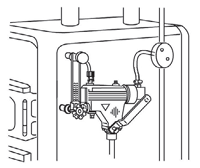
Figure 1. How do you check one of these? Do you get the burner running and drain the cutoff until the burner shuts off? Well if you do, youíre doing it wrong. All youíre doing is flushing the cutoff and the burner happens to go out. How do you know that all of the cutoff piping is clear? What if one of the sections is plugged?
On commercial equipment, what if a mud-drum is plugged? The only correct way is to get the burner running and drain the boiler until the burner shuts off according to ASME and thatís a fact! The same test goes true for probe types, Figure 2, but in addition you
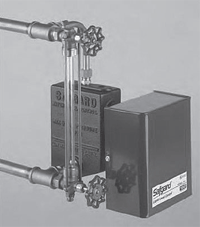 must also verify that the probe is clean and check the cutoff for operation. That doesnít mean checking it by pushing a Ďtest buttoní,címon youíre supposed to be the pro on the job and this is a Ďroutine or annual checkí, not a quick test. Clean the probe according to the OEMís recommendations, donít use Teflon when putting it back in. must also verify that the probe is clean and check the cutoff for operation. That doesnít mean checking it by pushing a Ďtest buttoní,címon youíre supposed to be the pro on the job and this is a Ďroutine or annual checkí, not a quick test. Clean the probe according to the OEMís recommendations, donít use Teflon when putting it back in.
Teflon is an insulator, and make sure that the sensor doesnít come within a ? of an inch from any metal in the boiler or piping. On a water boiler this whole procedure could become a P-I-T-A with a three or six story building above you.
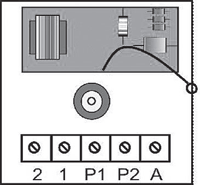
So, Iíll give you a couple of more ideas. The first is a test procedure from my
friends at Hydrolevel and is another unscientific way of checking a probe.
Take the wire off the probe and turn on the burner, it should not start. Now turn off the power again. Take the probe wire off the probe and place it on the case of the cutoff, Figure 3, the burner should immediately start. Finally, here is a test procedure using a meter and a little rig that I sell on my website, Figure 4.
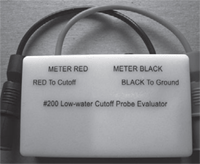 Essentially it proves the probe is working by passing a small DC charge through the water and back to the probe. You use it as shown in Figure 5 and you have a great way to CYA and get the job done. Essentially it proves the probe is working by passing a small DC charge through the water and back to the probe. You use it as shown in Figure 5 and you have a great way to CYA and get the job done.
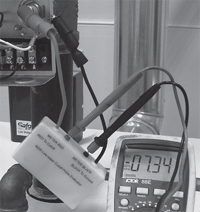
So, if you ever get dragged into a deposition or have to give testimony on how to check a low-water cutoff, now you know the Ďcorrect wayí. By the way, hopefully Iíll see you on DragonTalk. See ya.
* GeorgeLanthier is the owner of Firedragon Enterprises, a teaching, publishing and consulting firm. He is an industry trainer and the author of over 25 books on
oil heating and HVAC subjects. He can be reached at 608 Moose Hill Road, Leicester, MA 01524. His phone is 508-421-3490, fax at 508-421-3477 and his web-site and chat room can be found
at www.FiredragonEnt.com
###
|